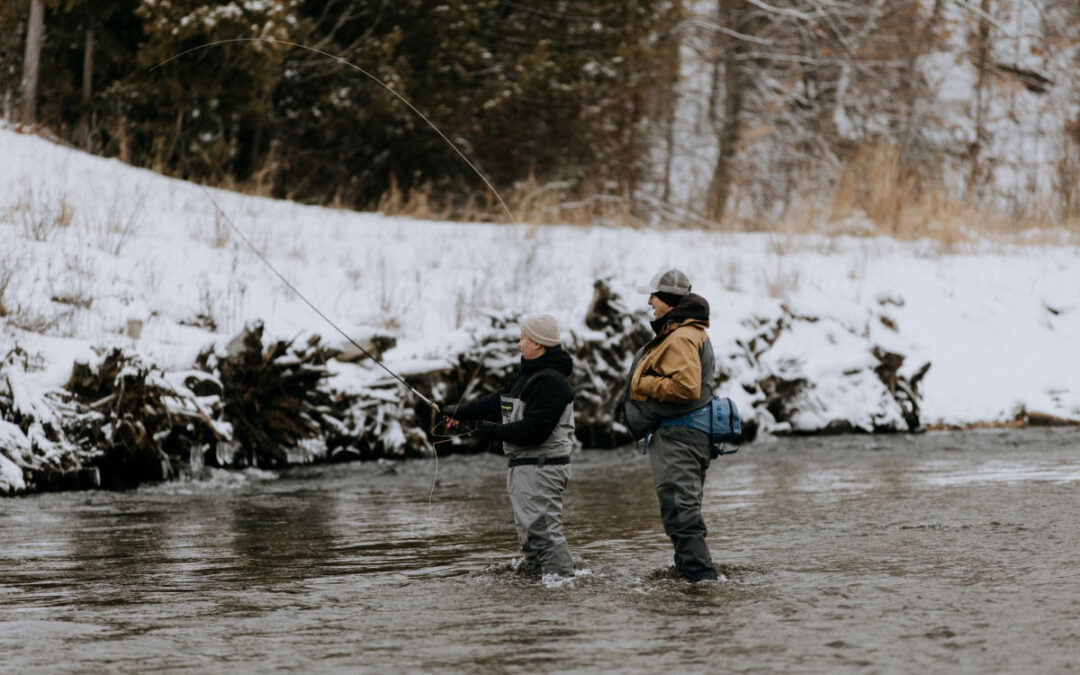The weather forecaster was right: A gentle blanket of snow covered the downtown Traverse City streets overnight. My 7:00 a.m. wake-up call at Hotel Indigo came with a mesmerizing view of Grand Traverse Bay. Gazing across the glistening water, I nearly fell back into a dream as I envisioned the winding riverbanks of the Boardman River that were also bound to reflect this magical winter charm. The Boardman River was today’s destination for my first-ever winter fly fishing trip.
After slipping into my thick fleece base layers, I pack up the rest of my cold-weather gear and head out to meet my Orvis fishing guides at Mundos 305, a local coffee shop a short five-minute walk away. The frigid air stings my cheeks while crossing the pedestrian footbridge over the downtown stretch of the Boardman River. Also known as the Ottaway River to the Grand Traverse Band of Ottawa and Chippewa Indians, it stretches 28 miles from Kalkaska to the mouth of the Grand Traverse Bay. I stop halfway across the bridge and peer down the river, imagining how cold it will feel on my legs when we wade into the slow-moving water.
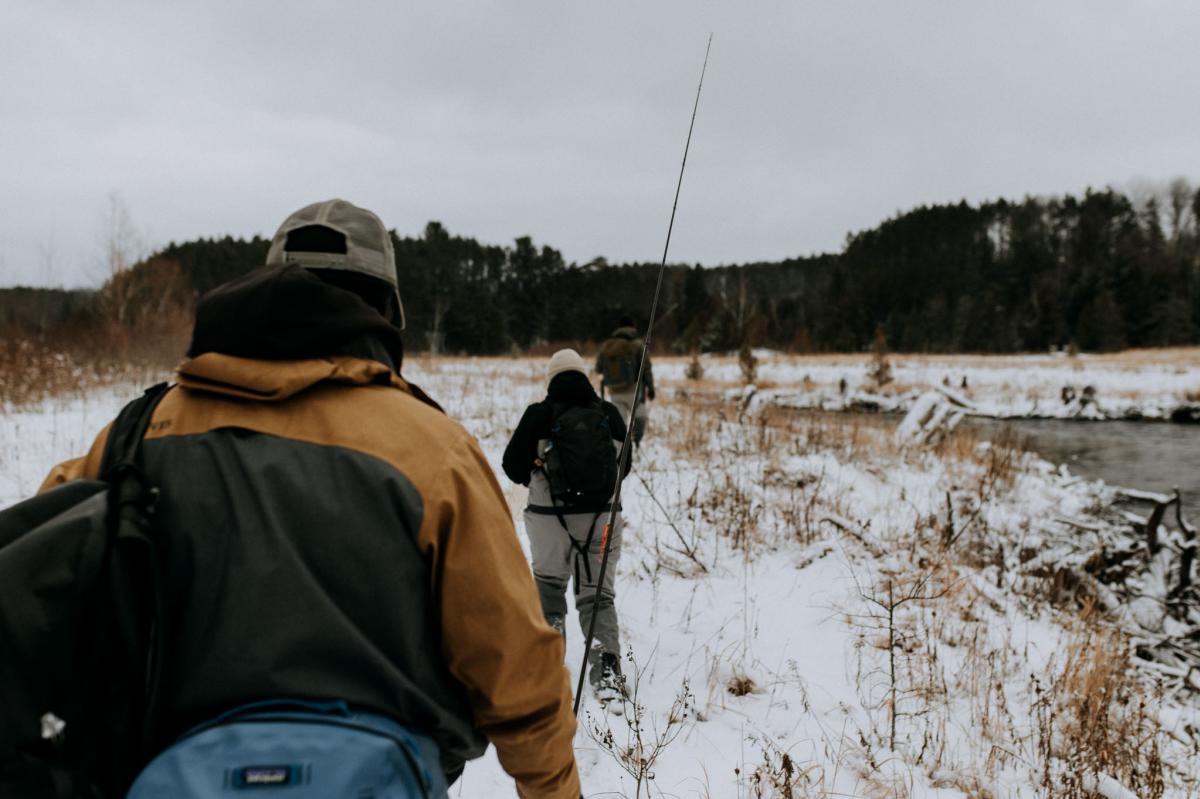
I continue on to Mundos, where I’m greeted by Greg Miller, the head fly fishing guide at Orvis Streamside, a local fly fishing shop in downtown Traverse City, and his co-guide, Tyler Sarasin, the shop manager. Their friendly handshakes and the visual queue of worn-in fishing caps confirm I’m in good hands. We order delicious breakfast burritos and pour-over coffees before sitting down to discuss our itinerary for the adventure ahead.
Greg explains that we’ll start at “The Meadows” within the Grand Traverse Natural Education Reserve, located 15 minutes south of downtown just north of the Cass Road bridge and Jack’s Landing. After, we’ll head to Sheck’s State Forest Campground to warm up around the campfire with lunch, before ending our day with a short half-mile hike on Olsen’s Bridge Trail to a scenic and wooded tucked-away fishing spot. Greg shares that popular fly fishing locations, like Sheck’s and Brown Bridge Quiet Area, are closed for the season during winter. Others remain open, like where we’ll fish today. The season in the Grand Traverse area — well-known for its abundance of brown trout, brook trout, and steelhead — officially opens at the end of April and runs through September. In the winter, however, anglers can take on the challenge of fishing quieter waters with the benefit of having the river to themselves.
Winter Wonder
Our 15-minute drive feels like an eternity. I’m clearly itching to get on the water. We arrive at The Meadows and I step out of Greg’s truck, inhaling a deep breath of crisp winter air. We unload our hearty stock fly fishing gear — jackets, waders, packs, boots, fly rods, and all — to a nearby pavilion. Greg and Tyler teach me how to properly suit up in my waders and I slip my feet inside my thick wading boots. Thankfully, the guides took care of rigging up my fly rod ahead of time so it doesn’t take long before we head out for the water.
I’m amazed at the landscape as we make our way along a quiet trail down to the river. Soft, fluffy white snow blankets the entire forest around us. We duck under weighted pine branches from the snow and I carry our fishing net on my shoulder, my inner child exploding inside. The Boardman River comes into sight and it stretches out before me. Its chilly water glints in the late morning light. It’s a scene of serene beauty, yet I’m aware of the challenge ahead. Winter fly fishing demands focus, determination, and deep knowledge of the art of angling. I’m already feeling grateful for the expertise Greg and Tyler will share with me on this new adventure.
We veer off the trail and walk down the hillside, crossing a small stream next to the riverbank. The warm brown and tan tones among the tall grasses, and the dark water under cloudy skies, pop against the untouched snow. We set down our gear and wade into the water with our fly rods in hand. Our waterproof waders and neoprene booties keep the cold water off of our skin. I’m quickly surprised and relieved by how warm I feel while standing in the Boardman. It’s actually warmer in the water than on the shoreline where the cold air blows against our bodies. The river ripples against rocks in the shallower water — one of my favorite sounds — and there’s no one else in sight. That’s one of the perks of fishing in the wintertime: complete solitude.
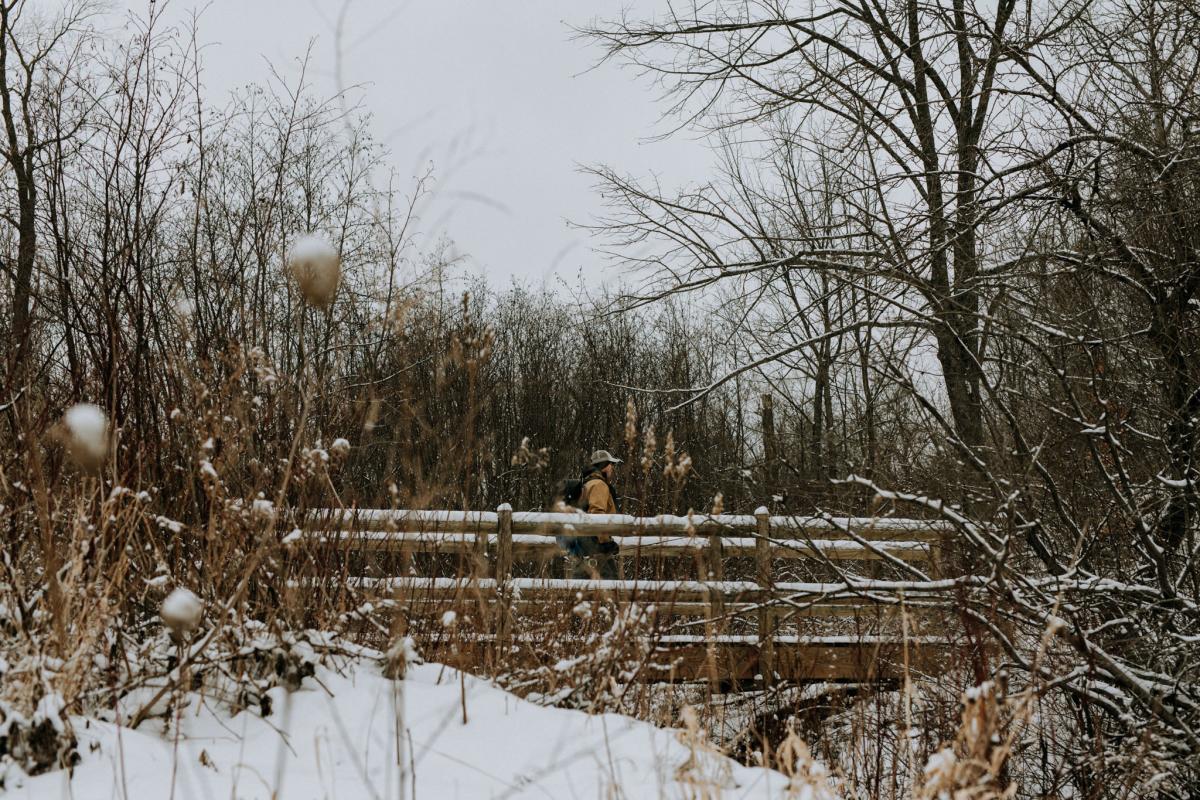
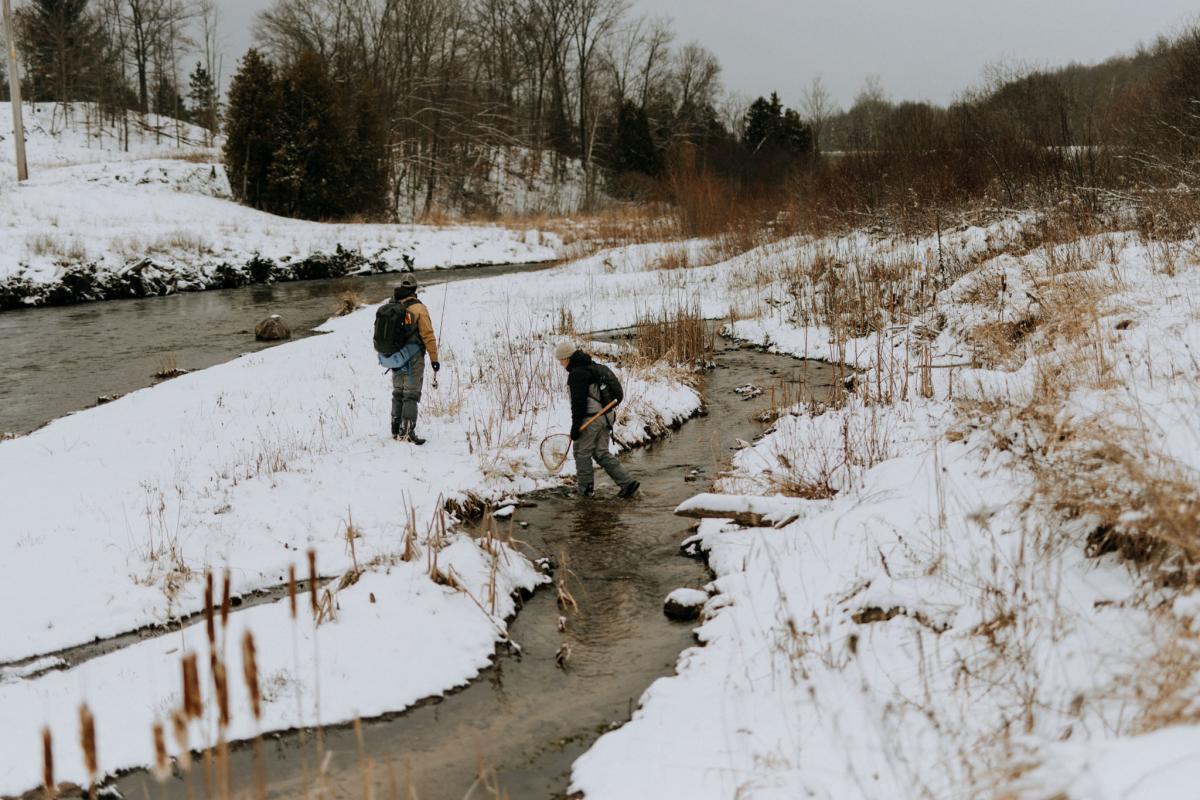
Greg eyes a deep pocket across the run or the fast-moving current running down the middle of the river. “We’ll fish the closest spots first and go gradually further and further across the river,” he says. “That way we’re not scaring any fish away that may be closer to us. We want to fish on the softer inside waters of the run first, then in the run, and then on the other side of the run.”
Walking a little further into shin-deep water, Greg refreshes my memory of casting the fly rod. Like dancing, we follow a series of methodical steps to achieve a smooth and accurate cast. Gripping the rod gently but firmly, I backcast and swiftly flick my wrist forward to drop the fly line delicately into the water so as not to scare the fish below. The swift current carries the line downstream with the fly bait drifting underneath the surface. We continue this movement — this dance — through each section of the river in front of us and slowly make our way downstream.
“In the summer, you’re going to want to search the bushes that line the river for clues as to what kind of bait or fly you’ll use,” says Tyler. “You’ll also seek out spider webs, which will show you what flying insects are out and active. In the winter, you’ll find these clues in the logs and underneath stones. Grab a piece of driftwood or rock, turn it over, and see what you can find.”
Tyler grabs a two-foot log lodged within roughage on the shoreline. We gather around to see what signs of life we can find within the waterlogged wood. “Oh, that’s a goby — a baitfish,” he says, pointing to a small brown and slippery-looking fish that slides deeper into a crevasse in the log. “And there’s a stonefly crawling out right there. Now you know what these fish are eatin’.”

He grabs a two-inch black stonefly from the log and it crawls onto his glove. This black stonefly nymph is a telltale sign of the steelhead that calls this river home. At first, I’m slightly grossed out, but then I remember: this is nature. It’s amazing to see the stonefly wiggling out of the water and then imagine fish below the surface gobbling up these insects as they float downstream. We’re using imitation black stonefly on our hooks and it’s helpful to see what the bait looks like in real life. By reading the signs of nature around you, you’re able to better understand what might be going on in the water, and more importantly, what fish are active below. As a new angler — and a female angler — it’s refreshing to have seasoned guides willing to teach me the art of fly fishing and answer all of my beginner questions.
We continue onwards down the winding river, climbing back up the riverbank and hiking down the shoreline until we find more spots that look promising. After an hour or so on the water, we decide to pack up and head to Sheck’s for lunch. No nibbles or set hooks, yet, but that’s okay. There’s still plenty of rivers to explore.
Nature’s Therapy
Our next stop is 20 minutes east at Scheck’s Campground. We drive through one of the most beautiful snowy forests I’ve ever seen. The truck tires seem to almost float on top of the undisturbed snow and we pass through a tunnel-like passage in the trees as we make our way further into the woods. We can have our pick of any of the campsites within the campground because, in these woods, we’re on our own. We opt for the spot closest to the water from the firepit and picnic table we choose, we have a perfect vantage point of the Boardman River which passes right through the campground.
Tyler builds a fire and Greg unloads lunch from his truck. Over a propane camp stove, we reheat a pot of Greg’s homemade beef and bean chili and snack on a charcuterie spread with local venison jerky and an array of cheese and crackers. Warming up in the woods next to the piping-hot bonfire, I’m amazed at how quiet it is. All we can hear is the occasional crackle of the logs and the ripple of the river only 20 feet away. I can feel the simplicity and calmness of the forest soaking into my veins. Traverse City winters don’t get much better than this.
While I could’ve stayed at Sheck’s the rest of the day, I also could feel an almost magnetic pull leading me back to the river. Car packed and bellies now full, we head to another section of the Boardman that’s also open during the winter. The spot is only five minutes south of our first fishing spot, just south of Jack’s Landing and Keystone Pond. We pull up to the Oleson Bridge Trailhead and unpack the car and hit the trail.
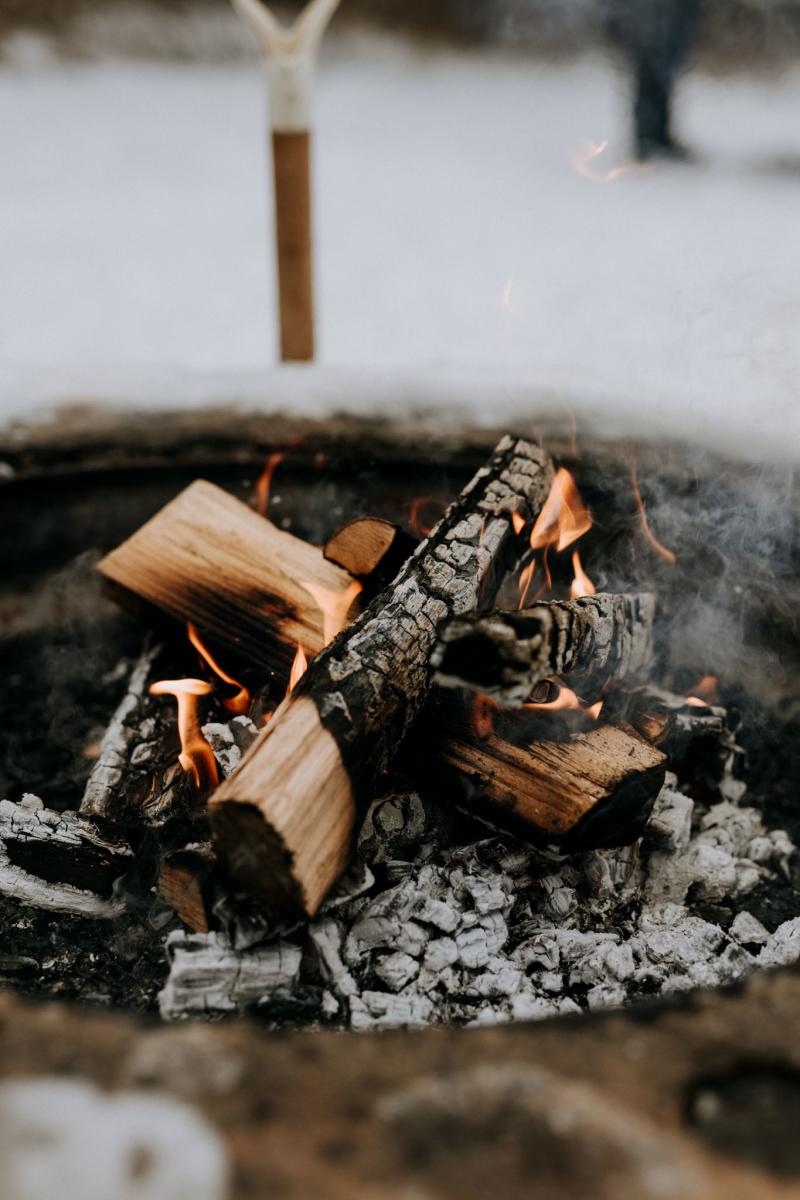
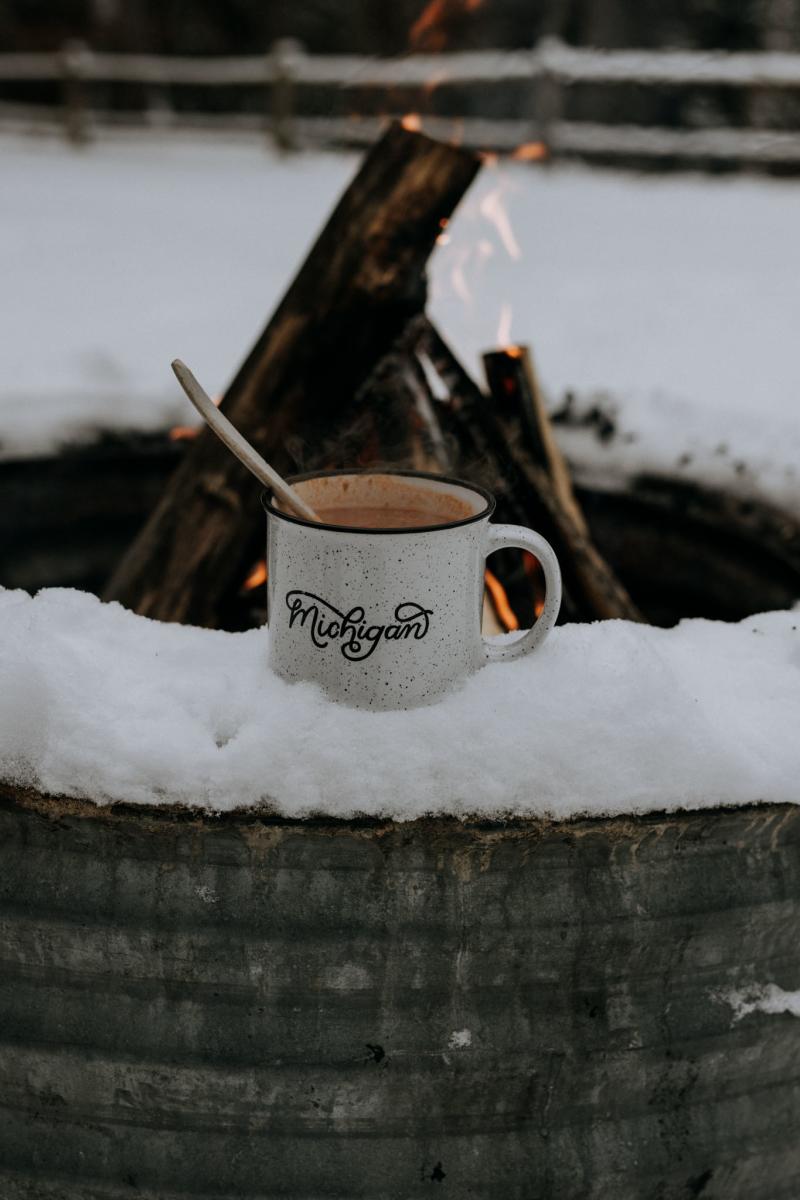
It’s rewarding to hike into a fly fishing spot. Not only because you’re likely to see fewer people when you get there but also because of the nature you get to take in along the way. While we walk, I ask Greg about what types of fish are native to this region, and if we’re to catch one today, what kind we can expect to reel in.
“Technically speaking, steelhead and brown trout are not native to Michigan but they have been spawning naturally in our rivers since the early 1900s,” says Greg. “You can also find native brook trout in the river, although, there’s some debate as to whether these fish are native or not. No stocking occurs in the section of the river where we are fishing today and these fish populations are entirely dependent on natural reproduction.”
I’m curious about the benefits of fly fishing for native fish and Greg fills me in that it’s less common these days to fish areas with wild trout. “It’s a fun challenge to catch wild fish, which I find are more wily and vibrant — and harder to catch,” he says.
We finally arrive at our secluded spot in the woods. I wade myself into the water with my rod in hand. As I cast my line in repetition, my body relaxes and my subconscious takes over. The sound of the rushing river turns into a soothing background hum and I’m only focused on the water. The rhythm of my casts is meditative and I find myself fully immersed in the moment. I’m starting to feel like a real angler, especially because I recognize that it’s not just about the thrill of the catch, but the serenity of the surroundings and the peace that it brings.
The end of our day nears yet we still don’t have a fish. With one last cast of my line, I flick my wrist with a simple wish for the thrill of a challenge. Instead, it delicately follows in the current of the river with no tug on the other end. I reel my line in for the final time that day. While enticing to give in to frustration, I’m actually feeling quite the opposite. For me, this experience of winter fly fishing on the Boardman River is one that filled my soul and quenched my thirst for adventure. It reminds me that even in the depth of winter there’s beauty and wonder to be found. More than anything, it’s about the experience of welcoming and appreciating the simple joys that come with spending time in the great outdoors — especially in Traverse City.

